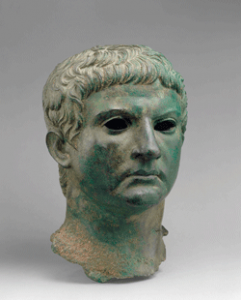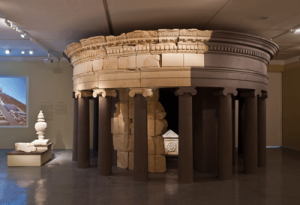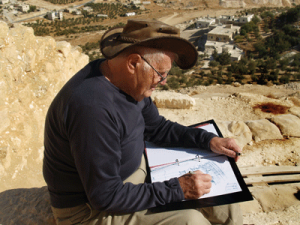Arts
Exhibit
The Arts: Herod Revisited

of the Metropolitan Museum of Art, NY.
Herod the Great was violent, ruthless, cruel, opportunistic, pathologically suspicious and given to bribery to escape danger. It seems that no king was ever hated by so many for so long. Just the story of his immediate family—his 10 wives and at least 14 children—with its intrigues and murders could furnish a multi-episode television drama starring this Roman-appointed king of the Jews as the villain.
But a blockbuster exhibition at the Israel Museum in Jerusalem (www.imj.org.il), which opened in February, explores a more nuanced view of the king who ruled Judea and neighboring areas between 37 B.C.E. and his death in 4 B.C.E.: his vision, creativity, diplomatic talent and administrative ability.
Not only is this “the most ambitious archaeological exhibition we have ever undertaken,” museum director James Snyder said at the opening, it is “the first exhibition anywhere on Herod.”
It is not surprising that it took so long for a museum to focus on this monarch. Although he was born a Jew—his Idumean grandfather was a convert—he was reviled by Jews for putting his loyalty to Rome first, introducing Hellenistic culture and executing the last of the Hasmoneans, the last ruling dynasty. Many Zionists were angry at his acceptance of Roman rule. Christians despised him, too, for the Slaughter of the Innocents recounted in the Christian Bible—the massacre of all young male children in the Bethlehem area to prevent a new king of the Jews from seizing his throne.
Even the Roman emperor Augustus, on learning that his friend and ally in the East had ordered the execution of his own son, reportedly remarked, “It is better to be Herod’s pig than his son.”
This negative view prevails to this day despite the assessment by exhibition co-curator Silvia Rozenberg that Herod’s notorious cruelty was not exceptional in comparison to that of other contemporary rulers. “That’s how the world worked in that period,” she said.
Herod, who erected many magnificent buildings throughout the region, left an inescapable mark on the landscape of the Land of Israel. His innovative and daring structures are the most-visited sites in modern Israel, the Golan Heights and the West Bank. Among them are the palaces in Masada, Caesarea, Jericho and Herodium; the large port of Caesarea; the monumental edifice above the Tomb of the Patriarchs in Hebron; the expanded city of Sebastia; the fortresses in Jerusalem, Masada and elsewhere; the temples honoring Augustus; the royal tomb at Herodium and, above all, the Temple Mount, supported in part by the Western Wall, on which he rebuilt the Temple.
According to Peter Richardson, professor of archaeology and architecture at the University of Toronto, “No one in the ancient world built as much as Herod did, with the possible exception of Augustus.”

his reconstructed mausoleum. Courtesy of Elie Posner.
The exhibition details many of Herod’s major projects, using computer animation to show how they were built, alongside objects excavated at the sites. The show’s title, “Herod the Great: The King’s Final Journey,” provides a narrative based on Herod’s funeral procession, which began in Jericho and ended at Herodium, where he had prepared an eight-story-high mausoleum that could be seen from Jerusalem, nearly eight miles to the north.
The funeral, as sumptuous as the king’s lifestyle, is described in great detail by Flavius Josephus, the Roman Jewish historian who chronicled Herod’s life—albeit writing more than 80 years after the king’s death—and is the main written source of information about him and his negative image.
According to Josephus, Herod lay in state in the throne room of his winter palace.
The bier was of solid gold, studded with precious stones, and had a covering of purple, embroidered with various colors; on this lay the body enveloped in a purple robe, a diadem encircling the head and surmounted by a crown of gold, the scepter beside his right hand.
The exhibition begins in this reconstructed throne room, with its original bright-red, ochre and light-blue frescoes, painted according to Rome’s latest fashion. It is a complex of winter palaces that reveal Herod’s genius in building on both sides of Wadi Qelt in this arid area, harnessing the winter floods and bringing water by aqueduct to fill Roman-style baths and pools and create lavish gardens. Planting pots with earth still in them and with holes for roots to grow are among the exhibits from Jericho, and a bathtub hewn from a single block of rare stone is from Cypros, the palace-fortress overlooking the Jerusalem-Jericho road.
The display continues through the Temple Mount and the Temple in Jerusalem (the largest sacred enclosure in the Roman world)—Herod’s greatest achievements. Here the emperor Augustus, his wife Livia and his general Marcus Agrippa paid for sacrifices to be made. Among the exhibits are stones from the Temple enclosure, richly ornamented with complex geometric and floral patterns.
The exhibition continues to Masada, with its desert fortress and its palace clinging to the mountain’s steep northern slope. On display are labeled jars from its storerooms that contained preserved onions, fine fish sauce from Spain and apples and top-quality wines from Italy.
Not only did Herod live in opulent palaces, he received guests with the finest food and vessels. The part of the exhibition devoted to Herod’s relations with Marc Antony and Cleopatra, and later with Augustus and the emperor’s closest friend and general, Marcus Agrippa, shows the types of luxury items with which he would have entertained his Roman visitors: multicolored glass drinking cups, silver wine cups ornamented with reliefs of leaves, fluted glass bowls and fired pottery dishes with a glossy red glaze. It also shows one of the reasons Cleopatra coveted Herod’s kingdom, associate curator Rachel Caine said: “Jericho and Ein Gedi were famous as sources of balsamon [balsam], a rare perfume also used as a remedy.” On display are a flask from Qumran and a jar labeled “balsam” in Hebrew and Aramaic.

Photo by Andrei Vainer/The Israel Museum, Jerusalem.
According to Rozenberg, the museum’s senior curator of classical archaeology, Herod was careful not to anger the Jews by introducing figurative art to Jerusalem—with the notable exception of the golden eagle, the symbol of imperial Rome, which he affixed to the main gate of the Temple. “But Herodium was far from Jerusalem,” she said. There he felt under no such constraints.
In lower Herodium, Caine said, Herod had built a “country club” with a large pool and even a pond on which boats sailed. A huge marble basin on display, found in a bathhouse, was ornamented with satyr-like Sileni heads and figures of winged women holding birds.
Herod also built a 300-seat theater at Herodium. Reconstructed for the exhibition are a colonnade from its upper section and a box for royal spectators, covered with frescoes and stuccoware. The frescoes include figurative art, for example, a naval scene that might be a representation of the Battle of Actium, in which Augustus defeated Cleopatra and Marc Antony. Also depicted on the frescoes is a picture “suspended” from a painted nail by a painted string, showing a scene from the Nile complete with a crocodile, and suggesting that the artist came from Alexandria.
“We made up the two pieces of frescoes from fragments,” Rozenberg said. “We have hundreds of boxes of fragments. If we had more room and time, we would exhibit them.”
Herod later destroyed the theater and everything else he had built at Herodium except the tomb, burying it under tons of rock taken from an adjacent hill, giving the mountain its volcano-like shape. His aim was to make his gleaming white hillside tomb the sole object visible from miles away.
And this tomb is the highlight of the exhibition. The circular upper part of the structure was brought from Herodium and reconstructed. Inside it was a sarcophagus, believed to be that of Herod, made of rare reddish local limestone, lacking figurative decoration in keeping with Jewish practice and ornamented only with carvings of rosettes and palmettos. The sarcophagus was found in pieces; according to Josephus, Jewish rebels smashed it around 66 C.E.
Ehud Netzer, the late archaeologist, was the moving spirit behind the exhibition. He was widely recognized as the world expert on Herodian architecture. Trained first as an architect, Netzer was entranced by Herod’s imaginative construction projects and devoted his professional life to uncovering the richness of that architectural achievement.
For four decades he also searched for the royal tomb at Herodium, looking for a burial cave, not a mausoleum, Caine said.
In 2007, “he came upon a podium of the mausoleum with the same technique as the ashlar walls of the Temple Mount,” Caine said. Then he discovered the sarcophagus. According to the archaeologist’s wife, Dvorah Netzer, he was 99-percent certain it was Herod’s.
Dvorah Netzer said it was her husband who approached the museum with the idea for an exhibition. On October 25, 2010, he toured Herodium from 6 A.M. with the museum team to decide what would be included in the show and what would be left at the site. Around 11:00 A.M. he phoned her in Jerusalem. “He was so happy,” she said. His dream of showing Herod’s positive side to the world was about to be realized.
Then he sat down to rest at his usual spot, leaning against a wooden railing. Suddenly the railing gave way and Netzer, 76, fell and was critically wounded. He died three days later.
After Netzer’s death, the museum’s staff labored for three years, piecing together tiny fragments of frescoes and other objects, including the royal sarcophagus. The exhibition is a success, Dvorah Netzer said, because the museum staff and the archaeologists worked together in a way that is most unusual in Israeli archaeology, “without politics, without ego.”
Some 75,000 people viewed the exhibition in its first eight weeks, according to a museum spokesperson. The demand for the show has been so great, she added, that the museum now issues timed tickets on weekends and has decided to extend the show through January 4, 2014.
While preparing the exhibition, the curators came to appreciate the positive sides of the reviled monarch.
“Herod brought 33 years of peace and prosperity to the region,” Rozenberg said. “He canceled taxes when there was a drought. And in 25 B.C.E., he gave the order to melt down all the metal objects of the palace to feed the people.” His construction projects, she added, provided paid work for many thousands of people.
In an essay in the lavish book accompanying the exhibition, Hebrew University historian Daniel R. Schwartz points out that modern historians, in contrast to Josephus who emphasized Herod’s negative aspects, “tend to revise the balance, giving the buildings much more space at the expense of those ancient crimes and tragedies.”
And indeed, visitors to the museum focused on the material record. Diane Curran, of Francestown, New Hampshire, a docent at the Currier Museum of Art in Manchester, New Hampshire, said she was impressed by Herod’s enormous footstep and that she was enchanted by the paintings in the royal room. “You could just walk in and imagine a banquet,” she said.
Tali Rosenfeld, of Jerusalem, said the exhibition shows “Herod’s complex story, with both the Jews and the Romans,” and that by bringing together all his works in one place “it shows his might.”
The discoveries regarding these monumental works were the outcome of Netzer’s single-minded determination to understand the king who had left such a huge mark on this region. Netzer’s widow described him as constantly thinking about Herod, whether in Israel or traveling abroad. Even at the brit “of our first grandchild, he sat on the side and wrote,” she recalled.
Dvorah Netzer, who was a social worker for 30 years at Hadassah–University Hospital on Mount Scopus, Jerusalem, also has a degree in archaeology. She met her husband while participating in the excavations of Masada, and throughout their marriage she served as his sounding board.
“For more than 30 years he would come home [every day] and spread out the papers on the table and show me what they had found,” she said. “He fell in love with and identified with this part of Herod…this creativity and originality and the amazing use he made of the conditions in every place. [Ehud] saw things as an architect, and he truly got inside Herod’s head.”
The exhibition is not the only project to grow out of Netzer’s life work. On January 14, the then-cabinet secretary Zvi Hauser announced a plan to build a full-scale reconstruction of Herod’s tomb at Herodium, to be made of plastic and to be visible from Jerusalem. It would be the first time such a reconstruction was carried out in an Israeli archaeological dig.
But the plan quickly became the subject of controversy. The daily Ha’aretz quoted leading archaeologists, who argued it would make a joke of the archaeological site and that the reconstruction would detract from the real thing. Even Netzer was not certain the reconstruction was a good thing, his widow said.
Following a public hearing in March at which additional objections were raised, officials in the prime minister’s office announced that the reconstruction plan had been scrapped.
Like the reconstruction plan, the exhibition itself is also the subject of controversy. Palestinian officials and some Israeli archaeologists have complained that taking objects from Herodium, which is in the West Bank, is a violation of the Oslo Accords.
Israeli archaeologist Yonathan Mizrachi of Emek Shaveh, an organization that focuses on the role of archaeology in the Israeli-Palestinian conflict, said the excavations at Herodium and the removal of objects from the site are violations of the 1954 Hague Convention (which was a response to damage and looting of cultural property during World War II). Ruins should not become tools in the service of a national struggle, his organization argues.
In response to Dvorah Netzer’s statement that her husband had asked the Palestinian authorities to participate in his excavations, Mizrachi said, “That’s like moving uninvited into someone’s home and then offering to share a room with them.”
The Israel Museum responded to objections in a statement: “The 1993 Oslo Agreement entrusted Israel with the care and protection of archaeological sites of historical, cultural and religious importance in the West Bank, so as to preserve the sites and protect them from looting, until a future final agreement determines and clarifies responsibility for the archeology of the region and its ownership.”
According to Dvorah Netzer, her husband had an agreement with the museum that the objects from Herodium would be returned to the site after the exhibition. James Snyder stated at the exhibit’s opening that the objects indeed would go back.
“We made sure that everything [in the exhibition] can be taken apart and put back together,” Rozenberg said.
Nita Schechet, the author of Disenthralling Ourselves: Rhetoric of Revenge and Reconciliation in Contemporary Israel (Fairleigh Dickenson University Press), commented that “both sides are partially right.”
But Netzer’s work and the exhibition were conducted with full transparency, and, she said, “that leaves the real issue of ownership unresolved, in a positive way, until determined by a political solution.”








 Facebook
Facebook Instagram
Instagram Twitter
Twitter
Leave a Reply